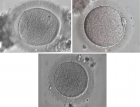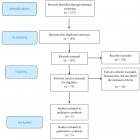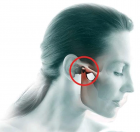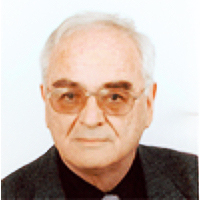Abstract
Case Report
Predictors of positive treatment response to PTNS in women with overactive bladder
Suneetha Rachaneni*, Doyo Enki, Megan Welstand, Thomasin Heggie and Anupreet Dua
Published: 18 January, 2022 | Volume 5 - Issue 1 | Pages: 001-004
Percutaneous tibial nerve stimulation (PTNS) is a non-invasive treatment for overactive bladder (OAB). PTNS involves peripheral neuromodulation that uses electrical stimulation to target the spinal cord roots, mainly S3, which controls bladder function. Neuromodulation is postulated to be the effect of cross-signaling between sympathetic and parasympathetic post ganglionic nerve terminals and synapses, causing alteration of nerve signals involved in the voiding reflex. de Groat, et al. described this neurophysiological process and the neural circuits involved in controlling the lower urinary tract [1]. Stimulation of peripheral nerves and subsequent “cross-talk” at the level of the postganglionic neuroeffector junctions can modulate transmission and facilitate detrusor inhibition [2].
Read Full Article HTML DOI: 10.29328/journal.cjog.1001097 Cite this Article Read Full Article PDF
Keywords:
Posterior tibial nerve stimulation; Women; Predictors of success; Overactive bladder; Urinary incontinence
References
- de Groat WC, Griffiths D, Yoshimura N: Neural control of the lower urinary tract. Comprehensive Physiology. 2015; 5: 327-396. PubMed: https://pubmed.ncbi.nlm.nih.gov/25589273/
- Hubscher CH, Gupta DS, Brink TS. Convergence and cross talk in urogenital neural circuitries. J Neurophysiol. 2013; 110: 1997-2005. PubMed: https://pubmed.ncbi.nlm.nih.gov/23926033/
- Klingler HC, Pycha A, Schmidbauer J, Marberger M. Use of peripheral neuromodulation of the S3 region for treatment of detrusor overactivity: a urodynamic-based study. Urology. 2000; 56: 766-771. PubMed: https://pubmed.ncbi.nlm.nih.gov/11068296/
- Vandoninck V, van Balken MR, Finazzi Agrò E, Petta F, Micali F, et al. Percutaneous tibial nerve stimulation in the treatment of overactive bladder: urodynamic data. Neurourol Urodyn. 2003; 22: 227-232. PubMed: https://pubmed.ncbi.nlm.nih.gov/12707873/
- Wang M, Jian Z, Ma Y, Jin X, Li H, et al. Percutaneous tibial nerve stimulation for overactive bladder syndrome: a systematic review and meta-analysis. Int Urogynecol J. 2020; 31: 2457-2471. PubMed: https://pubmed.ncbi.nlm.nih.gov/32681345/
- Del Río-Gonzalez S, Aragon IM, Castillo E, Milla-España F, Galacho A, et al. Percutaneous Tibial Nerve Stimulation Therapy for Overactive Bladder Syndrome: Clinical Effectiveness, Urodynamic, and Durability Evaluation. 2017; 108: 52-58. PubMed: https://pubmed.ncbi.nlm.nih.gov/28687483/
- Rostaminia G, Chang C, Pincus JB, Sand PK, Goldberg RP. Predictors of successful percutaneous tibial nerve stimulation (PTNS) in the treatment of overactive bladder syndrome. Int Urogynecol J. 2019; 30: 1735-1745. PubMed: https://pubmed.ncbi.nlm.nih.gov/30498931/
- van Balken MR, Vergunst H, Bemelmans BL. Prognostic factors for successful percutaneous tibial nerve stimulation. Eur Urol. 2006; 49: 360-365. PubMed: https://pubmed.ncbi.nlm.nih.gov/16359781/
- Pincus J, Rostaminia G, Chang C, Gafni-Kane A, Goldberg RP. Factors associated with overactive bladder symptom improvement after 1 year of monthly percutaneous tibial nerve stimulation therapy. Neurourol Urodynamics. 2019; 38: 1676-1684. PubMed: https://pubmed.ncbi.nlm.nih.gov/31107570/
- Iyer S, Laus K, Rugino A, Botros C, Lozo S, et al. Subjective and objective responses to PTNS and predictors for success: a retrospective cohort study of percutaneous tibial nerve stimulation for overactive bladder. Int Urogynecol J. 2019; 30: 1253-1259. PubMed: https://pubmed.ncbi.nlm.nih.gov/30467763/
- Kopcsay KS, Marczak TD, Jeppson PC, Cameron AP, Khavari R, et al. Treatment of refractory overactive bladder with OnabotulinumtoxinA vs PTNS: TROOP trial. Int Urogynecol J. 2022. PubMed: https://pubmed.ncbi.nlm.nih.gov/34993598/
Figures:
Similar Articles
-
TMD and pregnancy?Afa Bayramova*. TMD and pregnancy?. . 2018 doi: 10.29328/journal.cjog.1001001; 1: 001-006
-
Screening of Gestational diabetes mellitusGehan Farid*,Sarah Rabie Ali*,Reem Mohammed Kamal. Screening of Gestational diabetes mellitus . . 2018 doi: 10.29328/journal.cjog.1001003; 1: 014-023
-
Maternal and fetal outcome of comparative study between old & adopted new value of screening of Gestational Diabetes Mellitus in tertiary centre in Saudi ArabiaGehan Farid*,Reem Mohammed Kamal*,Mohamed AH Swaraldahab,Sarah Rabie Ali. Maternal and fetal outcome of comparative study between old & adopted new value of screening of Gestational Diabetes Mellitus in tertiary centre in Saudi Arabia. . 2018 doi: 10.29328/journal.cjog.1001005; 1: 026-034
-
Perinatal Morbidity & Mortality following repeat Cesarean section due to five or more previous Cesarean Section done in Tertiary centre in KSASomia Osman,Gehan Farid*,Reem Mohamed Kamal,Sarah Rabie Ali,Mohamed AH Swaraldahab. Perinatal Morbidity & Mortality following repeat Cesarean section due to five or more previous Cesarean Section done in Tertiary centre in KSA. . 2018 doi: 10.29328/journal.cjog.1001007; 1: 045-051
-
Septic arthritis of left shoulder in pregnancy following minor hand injuryNeelam Agrawal,Rhoughton Clemmey,Shamma Al-Inizi*. Septic arthritis of left shoulder in pregnancy following minor hand injury. . 2018 doi: 10.29328/journal.cjog.1001010; 1: 058-060
-
Value of ambulatory blood pressure measure in pregnancy hypertensionAna Correia*,Fátima Leitão. Value of ambulatory blood pressure measure in pregnancy hypertension. . 2018 doi: 10.29328/journal.cjog.1001012; 1: 067-072
-
Immediate postplacental insertion of intrauterine contraceptive device (copper 375) and its complications in term of expulsion, infection and perforationBenish Khanzada*,Mala Jitendra Shahani,Areesha Kamran Khanzada. Immediate postplacental insertion of intrauterine contraceptive device (copper 375) and its complications in term of expulsion, infection and perforation . . 2018 doi: 10.29328/journal.cjog.1001014; 1: 082-086
-
Managing epileptic women in pregnancySarmad Muhammad Soomar*,Saima Rajpali. Managing epileptic women in pregnancy. . 2019 doi: 10.29328/journal.cjog.1001015; 2: 001-002
-
Autoimmune encephalitis associated with an ovarian teratoma in a 29-year old womanA Plaikner*,A Jacob,J Rother,C Kohler. Autoimmune encephalitis associated with an ovarian teratoma in a 29-year old woman . . 2019 doi: 10.29328/journal.cjog.1001018; 2: 013-016
-
Trans-abdominal cervical cerclage revisitedJohn Svigos*. Trans-abdominal cervical cerclage revisited. . 2019 doi: 10.29328/journal.cjog.1001019; 2: 017-024
Recently Viewed
-
A Low-cost High-throughput Targeted Sequencing for the Accurate Detection of Respiratory Tract PathogenChangyan Ju, Chengbosen Zhou, Zhezhi Deng, Jingwei Gao, Weizhao Jiang, Hanbing Zeng, Haiwei Huang, Yongxiang Duan, David X Deng*. A Low-cost High-throughput Targeted Sequencing for the Accurate Detection of Respiratory Tract Pathogen. Int J Clin Virol. 2024: doi: 10.29328/journal.ijcv.1001056; 8: 001-007
-
A Comparative Study of Metoprolol and Amlodipine on Mortality, Disability and Complication in Acute StrokeJayantee Kalita*,Dhiraj Kumar,Nagendra B Gutti,Sandeep K Gupta,Anadi Mishra,Vivek Singh. A Comparative Study of Metoprolol and Amlodipine on Mortality, Disability and Complication in Acute Stroke. J Neurosci Neurol Disord. 2025: doi: 10.29328/journal.jnnd.1001108; 9: 039-045
-
Development of qualitative GC MS method for simultaneous identification of PM-CCM a modified illicit drugs preparation and its modern-day application in drug-facilitated crimesBhagat Singh*,Satish R Nailkar,Chetansen A Bhadkambekar,Suneel Prajapati,Sukhminder Kaur. Development of qualitative GC MS method for simultaneous identification of PM-CCM a modified illicit drugs preparation and its modern-day application in drug-facilitated crimes. J Forensic Sci Res. 2023: doi: 10.29328/journal.jfsr.1001043; 7: 004-010
-
A Gateway to Metal Resistance: Bacterial Response to Heavy Metal Toxicity in the Biological EnvironmentLoai Aljerf*,Nuha AlMasri. A Gateway to Metal Resistance: Bacterial Response to Heavy Metal Toxicity in the Biological Environment. Ann Adv Chem. 2018: doi: 10.29328/journal.aac.1001012; 2: 032-044
-
Obesity in Patients with Chronic Obstructive Pulmonary Disease as a Separate Clinical PhenotypeDaria A Prokonich*, Tatiana V Saprina, Ekaterina B Bukreeva. Obesity in Patients with Chronic Obstructive Pulmonary Disease as a Separate Clinical Phenotype. J Pulmonol Respir Res. 2024: doi: 10.29328/journal.jprr.1001060; 8: 053-055
Most Viewed
-
Evaluation of Biostimulants Based on Recovered Protein Hydrolysates from Animal By-products as Plant Growth EnhancersH Pérez-Aguilar*, M Lacruz-Asaro, F Arán-Ais. Evaluation of Biostimulants Based on Recovered Protein Hydrolysates from Animal By-products as Plant Growth Enhancers. J Plant Sci Phytopathol. 2023 doi: 10.29328/journal.jpsp.1001104; 7: 042-047
-
Sinonasal Myxoma Extending into the Orbit in a 4-Year Old: A Case PresentationJulian A Purrinos*, Ramzi Younis. Sinonasal Myxoma Extending into the Orbit in a 4-Year Old: A Case Presentation. Arch Case Rep. 2024 doi: 10.29328/journal.acr.1001099; 8: 075-077
-
Feasibility study of magnetic sensing for detecting single-neuron action potentialsDenis Tonini,Kai Wu,Renata Saha,Jian-Ping Wang*. Feasibility study of magnetic sensing for detecting single-neuron action potentials. Ann Biomed Sci Eng. 2022 doi: 10.29328/journal.abse.1001018; 6: 019-029
-
Pediatric Dysgerminoma: Unveiling a Rare Ovarian TumorFaten Limaiem*, Khalil Saffar, Ahmed Halouani. Pediatric Dysgerminoma: Unveiling a Rare Ovarian Tumor. Arch Case Rep. 2024 doi: 10.29328/journal.acr.1001087; 8: 010-013
-
Physical activity can change the physiological and psychological circumstances during COVID-19 pandemic: A narrative reviewKhashayar Maroufi*. Physical activity can change the physiological and psychological circumstances during COVID-19 pandemic: A narrative review. J Sports Med Ther. 2021 doi: 10.29328/journal.jsmt.1001051; 6: 001-007

HSPI: We're glad you're here. Please click "create a new Query" if you are a new visitor to our website and need further information from us.
If you are already a member of our network and need to keep track of any developments regarding a question you have already submitted, click "take me to my Query."




















































































































































